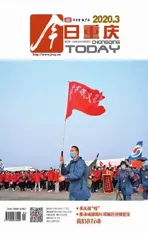回家的路,你用什么丈量?
——读《从大都到上都:在古道上重新发现中国》
2018-05-30◇文|田东
◇ 文| 田 东

最近的一场春运,刚从我们的视野里滑过。这场中国式的大迁徙,让《从大都到上都:在古道上重新发现中国》这本书显得尤其应景。书中,北大教授罗新花了十五天时间,从北京健德门徒步到内蒙古锡林郭勒盟正蓝旗,四百五十公里的旅途浓缩了一段帝国的历史,加上作者捕捉的种种细节、追忆和遐想,让行走在春运路上的我感慨良多。
Chunyun, the typical Chinese great migration during the Spring Festival, has just passed and it makes the book From Dadu to Shangdu-Rediscovering China in Ancient Paths come at a more appropriate time. In the book, Professor Luo Xin from Peking University spent fifteen days walking from Jian de men in Beijing to Zheng Lan flag in XilinGol League in Inner Mongolia Autonomous Region. The history of the empire was compacted in the 450 kilometers and the details the author captured and his memory and thoughts, make me think a lot travelling on Chunyun.
这是一条怎样的路?What road it is like?
大都,即今天的北京,元朝后来建都的地方。上都,则是忽必烈称汗以前金莲川幕府所在地开平府,其称汗后建立两都制,以燕京为大都,以开平为上都。乍看之下,有点像满清的北京和沈阳(那时的沈阳叫盛京,后改名奉天)。
每年初夏天气,麦田渐黄,暑气已至,元帝自大都前往开平(上都)。这条元朝皇帝们从大都到上都的路,便有了一个专门的名字——辇路。辇者,皇帝的专车,辇路,就是皇帝的专用车道。
这辇路分为两条:去路一条,回程一条。皇帝嘛,当然是不能走回头路的。单面要走二十多天。罗新写到,据刘佶《北巡私记》记载,元朝皇帝最后一次出健德门前往上都,是公元1368年9月11日,那天朱元璋的军队正步步紧逼元大都。皇帝凌晨三四点就出发了,带着三宫后妃一众人等“仓皇辞庙”,永别大都,逃命一般跑到上都,走了半个月。谁料抵达时,上都已遭明军焚掠,“公私扫地,宫殿官署皆焚毁”。
元顺帝不禁发出“朕不出京师,安知外事如此”的末日叹息。
Dadu, now Beijing, was where Yuan Dynasty built its capital. Shangdu is Kaiping official residence where Jinlianchuan Bakufu was before Kublai became Khan. He established two-capital systems and make Yanjing as Dadu and Kaiping as Shangdu, which was similar to Beijing and Shenyang in Qing Dynasty.
Every early summer, when the wheat fields were becoming yellow, and the heat has arrived, the Yuan emperor would leave Dadu for Kaiping(Shangdu). The road he travelled on was called imperial carriage road, which was exclusively for emperors.
The imperial carriage road has two ways, one way to go and the other for return, for the emperors cannot retrace his steps. It was recorded that it would take over twenty days for a single way. Luo Xin wrote, according to Liu Ji’s Bei Xun Si Ji(Journal of an Inspection Tour in the North), the last time when the Yuan emperor left Jian de men for Shangdu, on September 11, 1368,force of Zhu Yuanzhang was pressing hard on Yuan Dadu, so he ran away at 3a.m. with his concubines. But when they arrived at Shang du,it has already been plundered and burned out by Ming army.
Yuan Shun Emperor cannot help sighing“How could I know the current situation without going out the capital?”

为何徒步辇路?Why travel Imperial carriage road on foot?
这条几百年前曾仪仗威严的皇家道路,四百多公里长,罗新却花了十五天独自步行,而且心心念念了十多年方才成行。这是为什么呢?
十多年前,罗新读到朱有燉《元宫词百章》第十三首,便对重走辇路动了心思。当年风华正茂,如今渐生华发。他引用了美国作家斯坦贝克在《同查理一起旅行——寻找美国》中的话——
我幼小之时一心向往远方,大人说成长会治愈这种心痒。当岁月的流逝证实我已长大成人,他们开的药方又变成了中年。等到了中年,他们又说再大一些我就会降降温。现在我已经五十八岁了,也许他们还会说,年老了就好了。从来就不见效。轮船的四声鸣笛总让我汗毛直竖,踮起脚后跟。飞机掠过,发动机轰鸣,甚至马蹄敲击路面的声音,都会令我浑身战栗,口干眼燥,手心发烫,令肠胃在肋骨编织的牢笼里涌动翻腾。
2016年6月24日清晨六点半,罗新内心的翻腾化作了行动。北京健德门,他请路人给他拍了一张背对立交桥的逆光照片后,独自上路了。从大都的健德门出发,到上都的明德门,一位历史学教授开启了对研究对象的重新认识,以及对心灵家园的探望。出发前,他曾一再地问自己:“我,作为一个以研究中国历史为职业的人,真了解我所研究的中国吗?”
The over-four-hundred-kilometer-long royal road once standing for majesty several hundred years ago, took Luo Xin fifteen days to go on foot but it took him over ten years to do it. Why?
Ten years ago, when Luo Xin read about Court Ci in the Yuan Dynasty to the thirteen pieces, he was thinking about retracing the imperial carriage road. He was then in his prime time but he is now gradually grey. He quoted a passage from Travels with Charley, in Search of America by John Steinbeck:
When I was very young and the urge to be someplace else was on me, I was assured by parents that maturity would cure this itch. When I grew up, the remedy they prescribed was to hit middle age, upon which I was assured that greater age would calm my fever. Nothing has worked yet. I still feel urged and thirsty for a getaway.
At 6:30 a.m. of June 24th, 2016, Luo Xin set off on his own at Jian de men, having been taken a backlit photo by a passerby, and started rediscovering his research subject and visit his spiritual home. Before that, he repeatedly asked himself: “Do I, as a Chinese history profession,really know the country I have been studying for years?”
你在路上找到了什么?What did you find on the road?
这趟徒步旅行花了十五天,而写作此书,他花了一年。这些时间里,罗新不仅对这条于历史和现实都已隐约难辨的辇路有了更直观清晰也更感性的了解,也帮助他重返“青春与灵魂的家”。
该书甫一面世,便得盛誉。有说它是“49年以来中国大陆人写的关于中国的最重要的游记”,有说它是一本多角度的历史大散文。的确,余秋雨当年的《文化苦旅》引发的大散文热潮近年来已式微,历史为经、地理为纬、思索为魂的文章,似乎已不受青睐了。罗新的述说中,隐约可见前人的影子。
书中,一草一木,一砖一瓦,都成为连接过去与现在的时光机器。比如我们会知道,日本人类学家鸟居龙藏在1906年春到达内蒙古喀喇沁王府时,那里的松林已经由于过度砍伐减少了很多,不过王府附近的山上依旧栖息着虎、鹿之类的野生动物。他居住的宿舍靠近围墙,墙外常有狼群出没。
尽管“掉书袋”,不时喟叹历史和人生,但这不是一本“沉重”的书。罗新更像是一个讲故事的高手,文字简洁,文风明快。比如这一段——
他盯了我一会儿,说,嗯,你的身体可能受不了。我说,是的,可能受不了。他说,可能会受伤。我说,是的,可能会受伤。他问,你还是要走?我答,是的,我还是要走。他说,那么,我支持你。
春运路上,千万游子坐上飞机高铁,开着车,向着来时的角落出发。大多数人甚至来不及想,为什么出走,又为何归来。
罗新的文字,似乎正在唤醒着什么。
罗新用脚走出了心中翻腾十多年的“回家”之旅,用文字唤起了出走、回归与青春的记忆。我们呢,我们归家的路途与思绪,又该用什么来丈量,用什么来记录呢?
The hiking took him fifteen days while finishing this book took one year. During those days, he has a more direct, clearer, and perceptual understanding of the imperial carriage road and he also could return to the “home of youth and soul”.
The moment the book was published it became well known. Some said it is “the most important travel book written by mainland Chinese for forty-nine years”, and some said it is a multi-angle historical prose. Indeed,the great prose craze caused by Yu Qiuyu’s Cultural Perplexity in Agonized Travel has declined in recent years and writings in which history, geography and speculations running through seem to have gone out of favor. In Luo Xin’s book, the shadow of the former is faintly visible.
Grass, trees and bricks described in the book all become a time machine. For example, it writes that when Japanese anthropologist Torii Ryuzo went to Ka la qin Prince Mansion in the spring in 1906, the pine forest has reduced a lot due to deforestation but the mountain near Prince Mansion were still inhabited by some wild animals like tigers and deer. The dormitory Torii Ryuzo lived in was close to the wall and wolves often haunted outside the wall.




Despite many quotations and comments on history and life in the book, it is not a “heavy” one. Luo Xin is more like a good story-teller. His writings are concise and clear. Such as the following passage:
He stared at me for a while and said, “Well, your body may not stand it.” I said, “Probably yes.” He said, “You may get hurt.” I said, “Yes, I may get hurt.” He asked: “Do you still want to go?” I answered, “Yes, I still want to go.” He said, “So I support you.”
On the Chunyun, ten millions of people take airplane or high-speed train or driving their cars in the direction of coming. Many people even did not have time to think why they go out and why they go back.
Luo Xin seems to awake something by way of his words.
He measured the journey home on foot, which he has been thinking for more than ten years. His writing evoked memory of going out, coming back and youth. How about us? What should we use to measure the way home and thoughts and with what to record them?
